
This page was last updated on February 19, 2019





Uploaded on Jan 29, 2010 This video is an adaptation of the breezy Science on a Sphere production by supremely talented members of NASA's Scientific Visualization Studio. This video explores Jupiter's role as the 800 pound gorilla of our solar system, with stops on its fascinating moons and the big red spot. Additional video from NASA JPL and ESA Hubble. Category Science & Technology License Standard YouTube License


Image: Winds around Jupiter’s Great Red Spot are simulated in this JunoCam view that has been animated using a model of the winds there. The wind model, called a velocity field, was derived from data collected by NASA’s Voyager spacecraft and Earth-based telescopes. NASA’s Juno spacecraft acquired the original, static view during passage over the spot on July 10, 2017. Credit: NASA/JPL-Caltech/SwRI/MSSS/Gerald Eichstadt/Justin Cowart. If you’d like to dig into the analysis of radiation data, the paper is Kollman et al., “A heavy ion and proton radiation belt inside of Jupiter’s rings,” Geophys. Res. Lett 44, 5259-5268 (abstract).
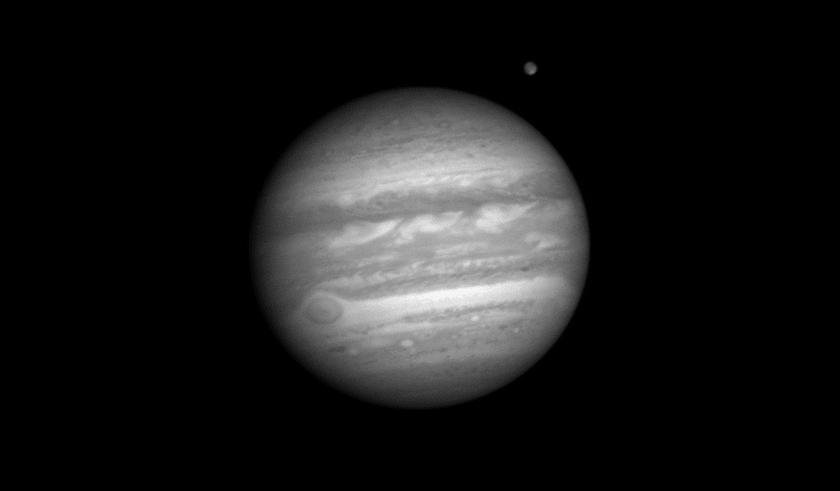
New Horizons' long-range camera LORRI monitored Jupiter's rotation as the spacecraft approached on January 9 and 10, 2007.
The 11 images in this animation were each taken an hour apart and cover one full rotation of the planet.
During the animation, first Ganymede and then Io cross the field of view, casting their shadows onto the planet.
There are a total of six of these movies planned for New Horizons' approach to Jupiter; the last of those should have been taken on Sunday,
so stay tuned to the New Horizons site for those. There are only three other sets of images planned for the next month: a handful of "Kodak moments,"
images taken primarily for their prettiness.
NASA / JHUAPL / SwRI / Animation by E. Lakdawalla
Published on Feb 8, 2017 This animation of Jupiter is made from more than 1,000 images taken by 91 amateurs from around the world between the 19th of December 2014 and the 31st of March 2015. After collecting the images, they have been remaped into cylindrical projections by Christoffer Svenske and Johan Warell. I have then color corrected, stacked and seamlessly stitched them into a total of 54 complete maps. To slow down the rapid motion, I have interpolated an image in between each pair of maps for a total of 107. The polar projections are a little special as I have made them stretch from pole to pole, not just from pole (center) to equator (outside) as traditionally represented. The reason is that I find it more interesting to be able to follow the movements of all the cloudbelts regardless of the projection. It has taken more than a year to complete this video that shows the motion of Jupiter's cloud belts and the rotation of the Great Red Spot in high resolution, all accelerated one million times! It also shows the technical skills of the world wide community of amateur planetary photographers to be able to reach this high level of details that can be tracked across the planet during 250 revolutions. Thanks to all of you for contributing to this project.
Voyager 3 from Peter Rosén on Vimeo.
In 1979, the Voyager 1 probe took a stunning series of images on its final approach to Jupiter that clearly showed the intricate movement of the cloudbelts for the first time. 35 years later, almost to the day, a group of 7 swedish amateur astronomers set out to replicate this odyssey and the historical NASA-footage but with images taken with their own ground-based telescopes. Welcome to the Voyager 3 Project.

Image: This graphic shows a new radiation zone surrounding Jupiter, located just above the atmosphere near the equator, that has been discovered by NASA’s Juno mission. The new radiation zone is depicted here as a glowing blue area around the planet’s middle. Meanwhile, Juno’s microwave radiometer (MWR) instrument also culled data during Juno’s passage over the Great Red Spot in July of 2017. The figure below represents six channels of these data. Using the MWR, Juno can see deeper than any previous ground- or space-based observations into the clouds. It’s interesting to note that the large-scale structure of the Great Red Spot is evident as deep into the planet as the MWR can observe. 16,000 kilometers wide, the Great Red Spot is a vast crimson storm that has been monitored since 1830. It was twice Earth’s diameter when the Voyagers studied it but has since diminished in width.
Credit: NASA/JPL-Caltech/SwRI/JHUAPL.

Image: This figure shows data from the six channels of the microwave radiometer (MWR) instrument onboard NASA’s Juno spacecraft. The data were collected in the mission’s sixth science orbit (referred to as “perijove 7”), during which the spacecraft passed over Jupiter’s Great Red Spot. The top layer in the figure is a visible light image from the mission’s JunoCam instrument, provided for context. Credit: NASA/JPL-Caltech/SwRI.

The magnetic field of Jupiter and co-rotation enforcing currents. Credit: Wikipedia Commons/Ruslik0

The Juno spacecraft will provide insights on how Jupiter's magnetic field is generated.
Credit: NASA Goddard Space Flight Center.
Jupiter's magnetosphere - a basic view. Read more: This video is public domain and may be downloaded at: Credits: NASA's Scientific Visualization Studio/JPL NAIF Tom Bridgman (GST): Lead Animator Mara Johnson-Groh (Wyle Information Systems): Writer Laurence Schuler (ADNET Systems, Inc.): Project Support Ian Jones (ADNET Systems, Inc.): Project Support

Published on Jun 29, 2016 NASA is sending the Juno spacecraft to Jupiter, to peer beneath its cloudy surface
and explore the giant planet's structure and magnetic field. Juno's twin magnetometers,
built at Goddard Space Flight Center, will give scientists their first look within Jupiter
at the powerful dynamo that drives its magnetic field. In this interview, Deputy Principal Investigator
Jack Connerney discusses the Juno mission and its magnetometers.
This video is public domain and :can be downloaded from the Scientific Visualization Studio at Credit: NASA/Goddard/Daniel Gallagher Music from the Killer Tracks catalog: "Beep" – Niklas Ahman "Jupiter's Eye" – Christian Telford, David Travis Edwards, Matthew St Laurent, and Robert Anthony Navarro "Original Conquest" –Laurent Dury "Through the Mist" – Andrew Britton and David Goldsmith "Lost Roads" – Gregg Lehrman
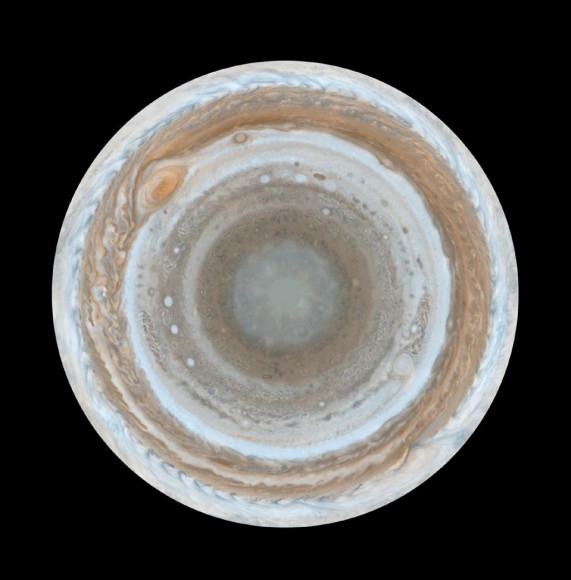
A view the Cassini spacecraft took during its flyby of Jupiter?s southern pole in 2000. Credit: NASA/JPL/Space Science Institute
Gimme a rocketship ? we want to see what those bands are made of! This is a strange view of Jupiter,
a familiar gas giant that humanity has sent several spacecraft to. This particular view, taken in 2000
and highlighted on the European Space Agency website recently, shows the southern hemisphere of the mighty planet.
The main page for Galelio Countdown(Legacy Page)

Amateur astronomers regularly analyse their own observations and many participate in studies of the atmosphere of Jupiter.
This image shows a nearly full map of Jupiter compiled by the Italian amateur astronomer,
Marco Vedovato, from observations obtained by Tiziano Olivetti in Thailand, Christopher Go in the Philippines,
and Alexei Pace in Malta. Full maps like this are only possible through the collaboration from observers around the world.
The composition of these images by other amateurs like Marco Vedovato helps scientists in their effort to characterise the
dynamic atmosphere of Jupiter. Image credit: M. Vedovato/T. Olivetti/C. Go/A. Pace.

Jupiter’s structure and composition. (Image Credit: Kelvinsong CC by S.A. 3.0)


A “family portrait” of the four Galilean satellites (Io Europa, Ganymede and Callisto) around Jupiter,
taken by the New Horizons spacecraft and released in 2007.
Credit: NASA/Johns Hopkins University Applied Physics Laboratory/Southwest Research Institute
Published on Oct 13, 2015 New imagery from NASA’s Hubble Space Telescope is revealing details never before seen on Jupiter.
High-resolution maps and spinning globes (rendered in the 4k Ultra HD format) are the first products
to come from a program to study the solar system’s outer planets each year using Hubble.
The observations are designed to capture a broad range of features, including winds, clouds,
storms and atmospheric chemistry. These annual studies will help current and future scientists
see how such giant worlds change over time. "This video is in the public domain. It can be downloaded along with the new Jupiter globes and maps Learn more at: http://www.nasa.gov/press-release/god... Like our videos? Subscribe to NASA's Goddard Shorts HD podcast: http://svs.gsfc.nasa.gov/vis/iTunes/f... Or find NASA Goddard Space Flight Center on Facebook: http://www.facebook.com/NASA.GSFC Or find us on Twitter: http://twitter.com/NASAGoddard Category Science & Technology License Standard YouTube License

The root of a dark matter hair produced from particles going through Jupiter’s core would be about 1 trillion times denser than average.
Credit: NASA/JPL-Caltech

This radio image of Jupiter was captured by the VLA in New Mexico. The three colors in the picture correspond
to three different radio wavelengths: 2 cm in blue, 3 cm in gold, and 6 cm in red. Synchrotron radiation produces the pink glow around the planet.
Image: Imke de Pater, Michael H. Wong (UC Berkeley), Robert J. Sault (Univ. Melbourne).

Two images of the Great Red Spot. The lower one is a Hubble optical image, showing the Spot and the familiar swirling cloud patterns.
The upper image is a radio map of the same region, showing the movement of ammonia up to 90 km below the clouds.
Credit: Radio image by Michael H. Wong, Imke de Pater (UC Berkeley), Robert J. Sault (Univ. Melbourne).
(Optical image by NASA, ESA, A.A. Simon (GSFC), M.H. Wong (UC Berkeley), and G.S. Orton (JPL-Caltech) )
OUMUAMUA WAS JUST THE BEGINNING. ASTRONOMERS FIND AN INTERSTELLAR ASTEROID ORBITING RETROGRADE NEAR JUPITER.

Image: Images of 2015 BZ509 obtained at the Large Binocular Telescope Observatory (LBTO) that established its retrograde co-orbital nature. The bright stars and the asteroid (circled in yellow) appear black and the sky white in this negative image. Credit: C. Veillet / Large Binocular Telescope Observatory. Namouni and Morais used computer simulations to track the errant asteroid back in time, arguing that 2015 BZ509 has moved this way since the birth of the Solar System some 4.5 billion years ago, an indication that it could not have formed there originally. The case also relies on the fact that the Sun formed in a tightly packed star cluster where movement of objects ejected by gravitational forces within their own system into orbits around other stars would not have been uncommon. Thus this rogue asteroid may well contain information about planet formation and evolution as well as telling us more about the Sun’s original siblings. So what exactly do we know about this object? 2015 BZ509 is in a resonant, co-orbital motion with Jupiter and represents the first discovery of a retrograde co-orbital asteroid with Jupiter or any other planet. Its orbital eccentricity of 0.3805 takes it inside and then outside of Jupiter’s orbit at its closest approaches (176 million kilometers). The orbital period is 11.65 years and the inclination is 163 degrees, an evidently stable orbit if a complicated one.

Illustration of Jupiter and the Galilean satellites. Credit: NASA

Artist’s impression of Jupiter’s moons, with the newly-discovered moons indicated in blue and red. Credit: Carnegie Institution of Science/Roberto Molar Candanosa



Juno has been headed for Jupiter since 2011 to study the gas giant’s atmosphere, aurora, gravity and magnetic field.
This infographic illustrates the radiation environments Juno has traveled through on its journey near Earth and in interplanetary space.
All of space is filled with particles, and when these particles get moving at high speeds, they’re called radiation.
NASA studies space radiation to better protect spacecraft as they travel through space, as well as to understand how this space environment
influences planetary evolution. After Jupiter orbit insertion on July 4, 2016, Juno will have the chance to study one of the most intense radiation
environments in our solar system.
Citizen-scientists Matt Brealey and Gustavo B C processed this color-enhanced image of a Jupiter storm using data captured on Feb. 7, 2018, by the JunoCam imager aboard NASA's Juno spacecraft. Credit: Matt Brealey/Gustavo B C/NASA/JPL-Caltech/SwRI/MSSS

JunoCam took this image during its eleventh close flyby of Jupiter on February 7, 2018. Image credit: NASA / JPL / SwRI / MSSS / David Marriott.

In preparation for the imminent arrival of NASA’s Juno spacecraft in July 2016,
astronomers used ESO’s Very Large Telescope to obtain spectacular new infrared images
of Jupiter using the VISIR instrument. This false-colour image was created by selecting
and combining the best images obtained from many short VISIR exposures at a wavelength of 5 micrometres.
Image credit: ESO/L. Fletcher.

False colour images generated from VLT observations in February 2016 (left) and March 2016 (right),
showing two different faces of Jupiter. The bluer areas are cold and cloud-free, the orangey areas are warm and cloudy,
more colourless bright regions are warm and cloud-free, and dark regions are cold and cloudy (such as the Great Red Spot
and the prominent ovals). The wave pattern over the North Equatorial Band shows up in orange.
These views were created from VLT/VISIR infrared images. The orange images were obtained at 10.7 micrometres wavelength
and highlight the different temperatures and presence of ammonia.
The blue images at 8.6 micrometres highlight variations in cloud opacity.
Image credit: ESO/L. Fletcher.

This view compares a lucky imaging view of Jupiter from VISIR (left) at infrared wavelengths with a
very sharp amateur image in visible light from about the same time (right).
Image credit: ESO/L. Fletcher/Damian Peach.
Home/News/Juno gets the first-ever view of Jupiter's North Pole Juno gets the first-ever view of Jupiter's North Pole Some never-before-seen features come to light. By Carl Engelking | Published: Friday, September 02, 2016

Even from afar, we always knew Jupiter was a bit of an oddball, and upon closer examination we were correct. On Aug. 27, NASA’s Juno spacecraft, with all its instruments blazing, swooped within 2,500 miles of the Jovian surface
and beamed back the first-ever images of its north pole. It was the first of 36 planned flybys planned for the mission,
so there’s plenty more where this came from. Still, even from the first 6-megabyte download, Jupiter’s revealing
why it’s unlike any other planet in our solar system.

An infrared glimpse at Jupiter’s south pole.
(Credit: NASA/JPL-Caltech/SwRI/MSSS) “First glimpse of Jupiter’s north pole, and it looks like nothing we have seen or imagined before,”
said Scott Bolton, principal investigator of Juno from the
Southwest Research Institute in San Antonio in a press statement Friday September 02, 2016.
Juno probe peers below Jupiter's clouds

This image from Juno’s JunoCam captured the south pole in visible light only. It’s a puzzle why the north and south poles are so similar, yet have a different number of cyclones. Image: NASA/JPL-Caltech/SwRI/MSSS/Betsy Asher Hall/Gervasio Robles Credit bbc.com"
GAZE IN WONDER AT JUPITER’S MYSTERIOUS GEOMETRIC POLAR STORMS

This wondrous image of Jupiter's south pole shows the arrangement of cyclones that is unique in our Solar System: five circumpolar cyclones perfectly arranged around a single polar cyclone. Image: NASA/SWRI/JPL/ASI/INAF/IAPS

This composite imageshows the central cyclone at the planet’s north pole and the eight cyclones that encircle it. Credit: NASA/JPL-Caltech/SwRI/ASI/INAF/JIRAM. This is hardly the orange, white and saffron belted world we are familiar with from telescope views of the lower latitudes. The scale of these storms is, as you would expect with Jupiter, quite impressive. Alberto Adriani is a Juno co-investigator based at the Institute for Space Astrophysics and Planetology in Rome:

This image captures the swirling cloud formations around the south pole of Jupiter, looking up toward the equatorial region. NASA’s Juno spacecraft took the color-enhanced image during its eleventh close flyby of the gas giant planet on Feb. 7, 2018 at 7:11 a.m. PST (10:11 a.m. EST). At the time, the spacecraft was 74,896 miles (120,533 kilometers) from the tops of Jupiter’s clouds at 84.9 degrees south latitude. Citizen scientist Gerald Eichstädt processed this image using data from the JunoCam imager. This image was created by reprocessing raw JunoCam data using trajectory and pointing data from the spacecraft. This image is one in a series of images taken in an experiment to capture the best results for illuminated parts of Jupiter's polar region. To make features more visible in Jupiter’s terminator — the region where day meets night — the Juno team adjusted JunoCam so that it would perform like a portrait photographer taking multiple photos at different exposures, hoping to capture one image with the intended light balance. For JunoCam to collect enough light to reveal features in Jupiter’s dark twilight zone, the much brighter illuminated day-side of Jupiter becomes overexposed with the higher exposure. JunoCam's raw images are available for the public to peruse and process into image products at: More information about Juno is at: and here Image credits: NASA/JPL-Caltech/SwRI/MSSS/Gerald Eichstädt

For almost 200 years humans have been watching the Great Red Spot (GRS) on Jupiter and wondering what’s behind it. Thanks to NASA’s Juno mission, we’ve been getting better and better looks at it. New images from JunoCam reveal some of the deeper detail in our Solar System’s longest-lived storm.

Images of Jupiter’s Great Red Spot have gotten better over the decades. On the left is an image from the Voyager mission, middle is an image from the Galileo mission, and on the right is a Hubble Space Telescope Image. Image: NASA/ESA/Evan Gough

JunoCam image of the Great Red Spot showing: Image: NASA/A. Sanchez-Lavega et. al.
- (A) compact cloud clusters;
- (B) mesoscale waves;
- (C) spiraling vortices;
- (D) a central turbulent nucleus;
- (E) examples of elongated thin dark gray filaments.

The study identifies five different morphological features in the Great Red Spot. From top to bottom:
- compact cloud clusters
- mesoscale waves
- spiraling vortices
- the central turbulent nucleus
- and large dark thin filaments
Image: American Astronomical Society/Sanchez-Lavega et al.

Technician’s install Juno’s titanium vault. (Image Credit: NASA/JPL-Caltech/LMSS)

The JUNO ProBe on it's way to Florida

Exploded diagram of the Juno Probe

Atlas Rocket Ready to launch

Juno Mission Clearing the Lightning Rod's Towers

Juno soars skyward to Jupiter on Aug. 5, 2011 from launch pad 41 at
Cape Canaveral Air Force Station at 12:25 p.m. EDT. View from the VAB roof.
Credit: Ken Kremer/

Juno Mission on the way!!!

Juno Mission Launch Vehicle Diagram
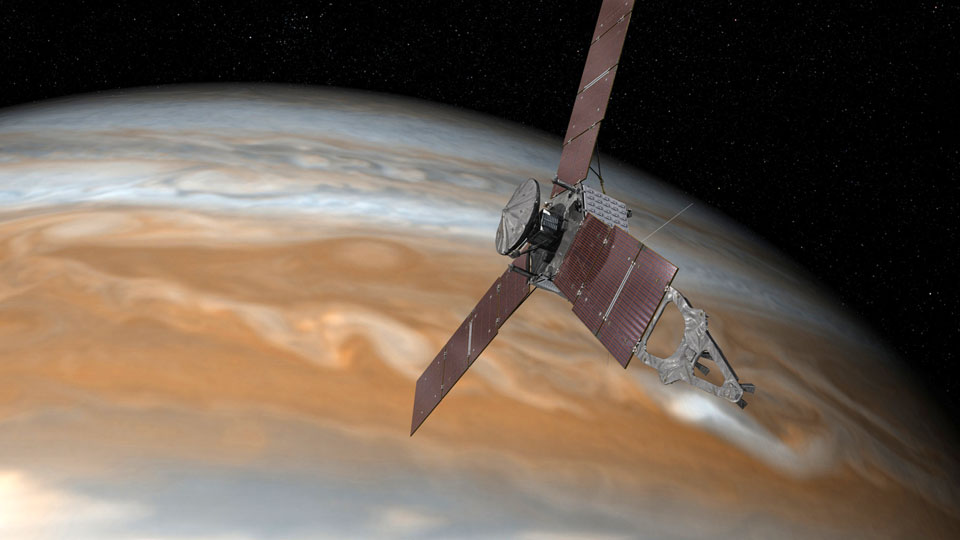
It's been a long time in coming, but NASA's Juno probe is finally close to reaching Jupiter.
NASA reports that the spacecraft is "on track" to arrive on July 4th, 2016 (how American!),
and that the ground crew is tweaking the flight plan to at once give Juno more time and complete tasks ahead of schedule.
The ship's initial orbit is splitting into two in order to test instruments before the science gathering starts.
Also, it'll take 14 days to complete an orbit rather than the originally planned 11.
[Image credit: NASA/JPL-Caltech]

Since its launch five years ago, there have been three forces tugging at NASA's Juno spacecraft
as it speeds through the solar system. The sun, Earth and Jupiter have all been influential --
a gravitational trifecta of sorts. At times, Earth was close enough to be the frontrunner.
More recently, the sun has had the most clout when it comes to Juno's trajectory.
Today, it can be reported that Jupiter is now in the gravitational driver’s seat,
and the basketball court-sized spacecraft is not looking back.

The Juno spacecraft will enter orbit around Jupiter on July 4, 2016,
picking up the exploration efforts NASA's Galileo mission began 20 years ago.


A computer-generated image of the Juno spacecraft. NASA/JPL-Caltech
and HERE
Find out more at Here
Juno's unique polar orbit is the key to the mission's design. What's so special about it?
Credit: NASA/JPL/SwRI
Category
Science & Technology
License
Standard YouTube License



This annotated color view of Jupiter and its four largest moons -- Io, Europa, Ganymede and Callisto --
was taken by the JunoCam camera on NASA's Juno spacecraft on June 21, 2016, at a distance of
6.8 million miles (10.9 million kilometers) from Jupiter.
Image credit: NASA/JPL-Caltech/MSSS

Lockheed Martin built the Juno spacecraft for NASA's Jet Propulsion Laboratory.
Credit: NASA/Lockheed Martin
and most lethal radiation belts. On July 4, 2016, NASA's Juno spacecraft will plunge into
uncharted territory, entering orbit around the gas giant and passing closer than any spacecraft before.
Juno will see Jupiter for what it really is, but first it must pass the trial of orbit insertion.
For more information:
and here
Category
Science & Technology
License
Standard YouTube License

New Juno image of Jupiter taken on Dec. 11, 2016. Processed by Damian Peach

This is the original image sent by JunoCam on Dec. 11 and features the eighth in a string of large storms in the planet’s southern hemisphere. Credit: NASA/JPL-Caltech/SwRI/MSSS

4-frame animation spans 24 Jovian days, or about 10 Earth days. The passage of time is accelerated by a factor of 600,000. Some of the ovals are visible as well as a variety of jets – west to east and east to west. Credit: NASA

Illustration of NASA's Juno spacecraft firing its main engine to slow down and go into orbit around Jupiter. Lockheed Martin built the Juno spacecraft for NASA's Jet Propulsion Laboratory. Credit: NASA/Lockheed Martin


False color view of Jupiter’s polar haze, created by citizen scientist Gerald Eichstädt using data from the JunoCam instrument. Credit: NASA/JPL-Caltech/SwRI/MSSS/Eric Jorgensen

To accomplish its science objectives, Juno is orbiting Jupiter’s poles and passing very close to the planet, avoiding the most powerful (and hazardous) radiation belts in the process. Credit: NASA/JPL-Caltech
Published on Feb 3, 2017 NASA’s Juno spacecraft made its latest close flyby of Jupiter Feb. 2 -- passing about 2,700 miles above the planet’s clouds. This was the fourth close flyby since Juno began orbiting Jupiter last year on July 4. During these close passes instruments on the spacecraft probe beneath the cloud cover to collect scientific data about the planet's structure, atmosphere and magnetosphere. This information could help us better understand the planetary systems being discovered around other stars. Also, Cassini Sees Saturn’s Rings in Greater Detail, The Most Extreme Blazars, NASA at Super Bowl Event, NASA at NBA Black Heritage Celebration, and Day of Remembrance! Category Science & Technology License Standard YouTube License

Jupiter’s south pole. captured by the JunoCam on Feb. 2, 2017, from an altitude of about 62,800 miles (101,000 kilometers) above the cloud tops. Credits: NASA/JPL-Caltech/SwRI/MSSS/John Landino

This amateur-processed image was taken on Dec. 11th, 2016, at 9:27 a.m. PST (12:27 p.m. EST), as NASA’s Juno spacecraft performed its third close flyby of Jupiter. Credits: NASA/JPL-Caltech/SwRI/MSSS/Eric Jorgensen
Published on Jun 23, 2016 Secrets lie deep within Jupiter, shrouded in the solar system's strongest magnetic field and most lethal radiation belts. On July 4, 2016, NASA's Juno spacecraft will plunge into uncharted territory, entering orbit around the gas giant and passing closer than any spacecraft before. Juno will see Jupiter for what it really is, but first it must pass the trial of orbit insertion. For more information: Category Science & Technology License Standard YouTube License
Published on Feb 3, 2017 NASA’s Juno spacecraft made its latest close flyby of Jupiter Feb. 2 -- passing about 2,700 miles above the planet’s clouds. This was the fourth close flyby since Juno began orbiting Jupiter last year on July 4. During these close passes instruments on the spacecraft probe beneath the cloud cover to collect scientific data about the planet's structure, atmosphere and magnetosphere. This information could help us better understand the planetary systems being discovered around other stars. Also, Cassini Sees Saturn’s Rings in Greater Detail, The Most Extreme Blazars, NASA at Super Bowl Event, NASA at NBA Black Heritage Celebration, and Day of Remembrance! Category Science & Technology License Standard YouTube License

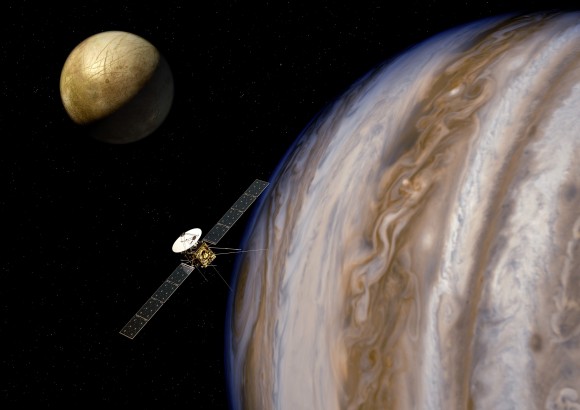
Artist?s impression of the Jupiter Icy Moons Explorer (JUICE) near Jupiter and one of its moons, Europa. Credit: ESA/AOES
It takes years of painstaking work to get a spacecraft off the ground. So when you have a spacecraft like JUICE (the Jupiter Icy Moons Explorer)
set to launch in 2022, you need to back up about a decade to get things figured out. How will the spacecraft get there?
What science instruments will it carry? What will the spacecraft look like and what systems will support its work?

SpaceX’s newly revealed Interplanetary Transit System will make travel to Mars, and other destinations in our Solar System, possible. Credit: SpaceX

More Frank R. Paul art this time showing the inhabitants of one of Jupiter's moons. This time it's weird penguin/chicken people.

An amazingly active Io, Jupiter’s “pizza moon” shows multiple volcanoes and hot spots in this photo taken with Juno’s infrared camera. Credit: NASA / JPL-Caltech / SwRI / ASI / INAF /JIRAM / Roman Tkachenko

Linda Morabito spotted the puzzling plume off Io’s limb in this photo, taken on March 8, 1979, three days after Voyager 1’s encounter with Jupiter. It really does look like another moon poking out from behind Io. A second plume over the terminator (border between day and night) catches the rays of the rising Sun. Credit: NASA / JPL

This map shows thermal emission from erupting volcanoes on Io. The larger the spot, the larger the thermal emission. Credit: NASA/JPL-Caltech/Bear Fight Institute
This five-frame sequence (Repeating Sequence on this video) of New Horizons images captures the giant plume from Io's Tvashtar volcano. Snapped by the probe's Long Range Reconnaissance Imager (LORRI) as the spacecraft flew past Jupiter earlier this year, this first-ever "movie" of an Io plume clearly shows motion in the cloud of volcanic debris, which extends 330 kilometers (200 miles) above the moon's surface. Only the upper part of the plume is visible from this vantage point -- the plume's source is 130 kilometers (80 miles) below the edge of Io's disk, on the far side of the moon. The appearance and motion of the plume is remarkably similar to an ornamental fountain on Earth, replicated on a gigantic scale. The knots and filaments that allow us to track the plume's motion are still mysterious, but this movie is likely to help scientists understand their origin, as well as provide unique information on the plume dynamics. Io's hyperactive nature is emphasized by the fact that two other volcanic plumes are also visible off the edge of Io's disk: Masubi at the 7 o'clock position, and a very faint plume, possibly from the volcano Zal, at the 10 o'clock position. Jupiter illuminates the night side of Io, and the most prominent feature visible on the disk is the dark horseshoe shape of the volcano Loki, likely an enormous lava lake. Boosaule Mons, which at 18 kilometers (11 miles) is the highest mountain on Io and one of the highest mountains in the solar system, pokes above the edge of the disk on the right side. The five images were obtained over an 8-minute span, with two minutes between frames, from 23.50 to 23.58 Universal Time on March 1, 2007. Io was 3.8 million kilometers (2.4 million miles) from New Horizons; the image is centered at Io coordinates 0 degrees north, 342 degrees west. The pictures were part of a sequence designed to look at Jupiter's rings, but planners included Io in the sequence because the moon was passing behind Jupiter's rings at the time.

Global view of Jupiter’s moon Io, obtained during the tenth orbit of Jupiter by NASA’s Galileo spacecraft. Credit: NASA

Enhanced-color Galileo image showing a dark spot produced by a major eruption at Pillan Patera in 1997. Credit: NASA/JPL

False-color mosaic of the surface of Io. Large mountains appear in dark grey and black. Credit: USGS Astrogeology Science Center

Model of the possible interior composition of Io with various features labelled. Credit: Wikipedia Commons/Kelvinsong

This five-frame sequence of images from NASA?s New Horizons mission captures the giant plume
from Io?s Tvashtar volcano in March, 2007.
Credit: NASA/Johns Hopkins University Applied Physics Laboratory/Southwest Research Institute.
Jupiter?s moon Io features at least 400 active volcanoes, making it the most volcanically active world in our Solar System.
However, the location of the volcanoes on Io just doesn?t match up with scientific models that predict how the moon?s interior is heated.
?Rigorous statistical analysis of the distribution of volcanoes in the new global geologic map of Io,?
said Christopher Hamilton of the University of Maryland, College Park and the Goddard Spaceflight Center.
?We found a systematic eastward offset between observed and predicted volcano locations that can?t be reconciled
with any existing solid body tidal heating models.?
Uploaded on Apr 30, 2011 A plume erupts from the Io's Tvashtar volcanic area as the moon transits Jupiter. Io's own shadow is visible as a dark disk on the Jupiter's cloud tops. Filaments (from an as yet unexplained mechanism) are visible in the plume. The appearance of Tvashtar's plume was based on this composite of images from the New Horizons spacecraft: Rendered in real time using the VESTA engine. Category Science & Technology License Standard YouTube License
Published on Apr 25, 2013 The so-called "volcanoes" on Jupiter's moon Io have long been conventionally interpreted as the effect of tidal forces acting on the moon.
But a recent scientific paper has announced that this longstanding explanation does not fit with the actual location of the plumes.
Is it possible that this failure of theory could cause planetary scientists to reconsider the electrical explanation first offered by
astrophysicist Thomas Gold and later by plasma scientists Anthony Peratt and Alex Dessler?
Subscribe to Thunderbolts Update weekly newsletter: http://eepurl.com/ETy41 Thunderbolts Project Home: http://www.thunderbolts.info Facebook: http://www.facebook.com/thunderboltsp... Picture of the Day: http://www.thunderbolts.info/wp/daily... Electric Universe (Wal Thornhill): http://www.holoscience.com/wp/ Essential Guide to the Electric Universe: http://www.thunderbolts.info/wp/eg-co... Category Science & Technology License Standard YouTube License

Pictures of Io’s auroral activity, captured by the Galileo spacecraft on October 16, 1998. Credit: NASA/JPL/University Of Arizona (PIRL)

Mosaic of Voyager 1 images of Io’s south polar region, which includes two of Io’s ten highest peaks –
Euboea Montes (upper right) and Haemus Mons (left). Credit: NASA/JPL/USGS

Time-lapse sequence of clear-filter images of Io during the eclipse of January 1, 2001.
Credit: NASA/JPL/USGS
Date: May 1, 2015
Source:University of Arizona
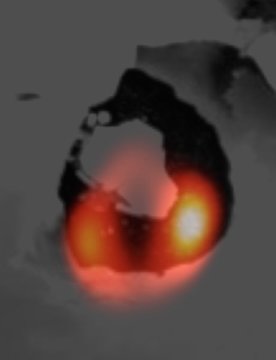
The LBT image of Loki Patera (orange) laid over a Voyager image of the volcanic depression.
The emission (in orange color) appears spread out in the north-south direction due to the telescope point-spread function;
it is mainly localized to the southern corners of the lake.
Credit: LBTO- NASA

Of Jupiter?s four large Galilean satellites, Io is the closest to the planet.
It?s about the same size as Europa and the Earth?s Moon. It may be the strangest satellite humans have ever studied.
Voyager photos of Io revealed erupting volcanoes. This wasn?t too surprising, because Jupiter?s intense tidal forces heat
the interior of the satellite, just like on Europa. But subsequent observations show that volcanoes are always erupting
on Io - in fact, it?s the most volcanically active world in the solar system! Material shot up by the many volcanoes
rises high above the surface of the little satellite and then falls back in a lazy arc due to Io?s weak gravity.
Volcanic activity adds about 10 centimeters of new material to the surface each year.
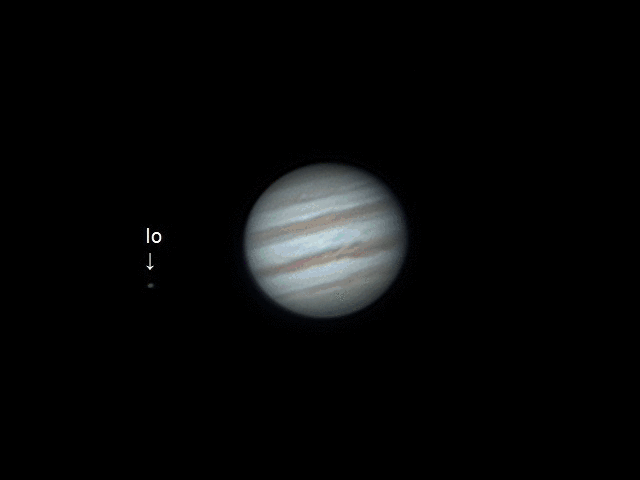
A Dec. 24, 2014 (EST) timelapse of Io transiting Jupiter. Credit: IKYLSP/Reddit
On Christmas Eve, as millions upon millions of people focused on wrapping gifts and getting ready for the holidays,
an amateur astronomer gave a small gift to the world. The person turned a telescope and camera to Jupiter and caught volcanic
Io going across the face of the gas giant. This happened just a few days after professional astronomers caught a rare eclipse
involving that very same moon.
Published on Apr 26, 2012 Io is the innermost of the four Galilean moons of Jupiter and, with a diameter of 3,642 kilometers, the fourth-largest moon in the Solar System.
It was named after Io, a priestess of Hera who became one of the lovers of Zeus. Nevertheless, it was simply referred to as Jupiter I, or
The first satellite of Jupiter, until mid-20th century. With over 400 active volcanoes, Io is the most geologically active object in the Solar System. Its surface is dotted with more than 100 mountains,
some which are taller than Earth's Mount Everest. Unlike most satellites in the outer Solar System (which have a thick coating of ice),
Io is primarily composed of silicate rock surrounding a molten iron or iron sulfide core. Although not proven, recent data from the Galileo orbiter indicates that Io might have its own magnetic field Io has an extremely
thin atmosphere made up mostly of sulfur dioxide (SO2). If a surface data or collection vessel were to land on Io in the future,
it would have to be extremely tough (similar to the tank-like bodies of the Soviet Venera landers) to survive the radiation and magnetic fields
that originate from Discovered by Galileo Galilei Discovery date January 7, 1610 Designations Alternate name Jupiter I Adjective Ionian Orbital characteristics Periapsis 420,000 km (0.002 807 AU) Apoapsis 423,400 km (0.002 830 AU) Mean orbit radius 421,700 km (0.002 819 AU) Eccentricity 0.0041 Orbital period 1.769 137 786 d (42 h) Average orbital speed 17.334 km/s Inclination 2.21° (to the ecliptic) 0.05° (to Jupiter's equator) Satellite of Jupiter Physical characteristics Dimensions 3,660.0 × 3,637.4 × 3,630.6 km Mean radius 1,821.3 km (0.286 Earths)[1] Surface area 41,910,000 km2 (0.082 Earths) Volume 2.53 × 1010 km3 (0.023 Earths) Mass 8.9319 × 1022 kg (0.015 Earths) Mean density 3.528 g/cm3 Equatorial surface gravity 1.796 m/s2 (0.183 g) Escape velocity 2.558 km/s Rotation period synchronous Equatorial rotation velocity 271 km/h Albedo 0.63 ± 0.02 Surface temp. Surface min mean max 130 K 200 K Apparent magnitude 5.02 (opposition) Atmosphere Surface pressure trace Composition 90% sulfur dioxide Category Science & Technology License Standard YouTube License
Published on Apr 25, 2013 The so-called "volcanoes" on Jupiter's moon Io have long been conventionally interpreted
as the effect of tidal forces acting on the moon. But a recent scientific paper has announced
that this longstanding explanation does not fit with the actual location of the plumes.
Is it possible that this failure of theory could cause planetary scientists to reconsider
the electrical explanation first offered by astrophysicist Thomas Gold and later by plasma scientists Anthony Peratt and Alex Dessler?
Subscribe to Thunderbolts Update weekly newsletter: http://eepurl.com/ETy41 Thunderbolts Project Home: http://www.thunderbolts.info Facebook: http://www.facebook.com/thunderboltsp... Picture of the Day: http://www.thunderbolts.info/wp/daily... Electric Universe (Wal Thornhill): http://www.holoscience.com/wp/ Essential Guide to the Electric Universe: http://www.thunderbolts.info/wp/eg-co... Category Science & Technology License Standard YouTube License

Infrared image of the southern hemisphere of Jupiter’s moon Io taken by NASA's Juno spacecraft on Dec. 16, 2017. Credits: NASA/JPL-Caltech/SwRI/ASI/INAF/JIRAM

Annotated image of the new heat source close to the south pole of Io, with a scale depicting the range of temperatures displayed in the infrared image. Credits: NASA/JPL-Caltech/SwRI/ASI/INAF/JIRAM

Thanks to a mission extension, NASA’s Juno probe continues to orbit Jupiter, being only the second spacecraft in history to do so. Since it arrived around the gas giant on July 5th, 2016, Juno has managed to gather a great deal of information on Jupiter’s atmosphere, magnetic and gravity environment, and its interior structure.

Reconstructed image acquired by the JunoCam at 12:20 (UTC) on Dec. 21, 2018. Credit: NASA/SwRI/MSSS

Image captured by Juno’s Stellar Reference Unit (SRU) camera shortly after Io was eclipsed by Jupiter at 12:40:29 (UTC) Dec. 21, 2018. Credit: NASA/JPL-Caltech/SwRI

Image acquired by the Jovian Infrared Auroral Mapper (JIRAM) at 12:30 (UTC) on Dec. 21st, 2018. Credit: NASA/JPL-Caltech/SwRI/INAF

These signals were recorded by the Voyager 1 plasma wave instrument as the spacecraft flew past Jupiter on March 5, 1979. Jovian whistler waves propagate at audio frequencies along closed field lines in Jupiter's magnetosphere. Like Earth whistlers, the higher frequency components of the Jovian whistler propagate faster than the lower frequency components, resulting in a descending whistling tone. Also like Earth whistlers, Jovian whistlers are generated by lightning discharges in the atmosphere. It was the detection of these signals that provided the first indirect evidence of lightning on the giant planet. The video shows a spectrogram with time along the horizontal axis, frequency on the vertical axis, and color-coded amplitude with weak signals blue and strong signals red. A moving cursor shows the time of the corresponding audio. For more information on the Voyager project: This is a sample from the collection of Prof Don Gurnett's favorite space audio recordings available from: For similar videos:


A low flyover of Jupiter's moon Europa using recently processed data from NASA's Galileo orbiter. Uses high resolution grayscale and low resolution color images taken between 1996 and 1998. Credit: NASA/JPL-Caltech/Kevin M. Gill Music: Kevin MacLeod via YouTube.

Image: These composite images show a suspected plume of material erupting two years apart from the same location on Jupiter’s icy moon Europa. The newly imaged plume, shown at right, rises about 100 kilometers above Europa’s frozen surface. The image was taken Feb. 22, 2016. The plume in the image at left, observed by Hubble on March 17, 2014, originates from the same location. It is estimated to be about 50 kilometers high. The snapshot of Europa, superimposed on the Hubble image, was assembled from data from NASA’s Galileo mission to Jupiter. Credit: NASA/ESA/W. Sparks (STScI)/USGS Astrogeology Science Center.

This composite image shows suspected plumes of water vapor erupting at the 7 o’clock position off the limb of Jupiter’s moon Europa. The Hubble data were taken on January 26, 2014.
Credit: Credits: NASA/ESA/W. Sparks (STScI)/USGS Astrogeology Science Center

Image: These images of the surface of the Jovian moon Europa, taken by NASA’s Galileo spacecraft, focus on a “region of interest” on the icy moon. The image at left traces the location of the erupting plumes of material, observed by NASA’s Hubble Space Telescope in 2014 and again in 2016. The plumes are located inside the area surrounded by the green oval. The green oval also corresponds to a warm region on Europa’s surface, as identified by the temperature map at right. The map is based on observations by the Galileo spacecraft. The warmest area is colored bright red. Credit: NASA/ESA/W. Sparks (STScI)/USGS Astrogeology Science Center.

NASA's Report on the Their Mission to Europa
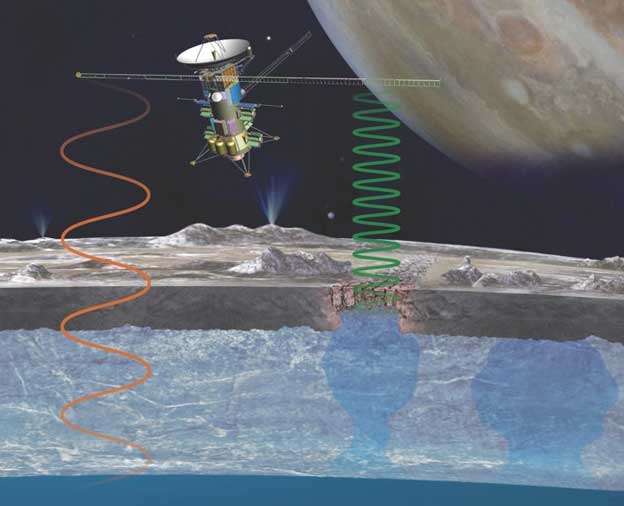
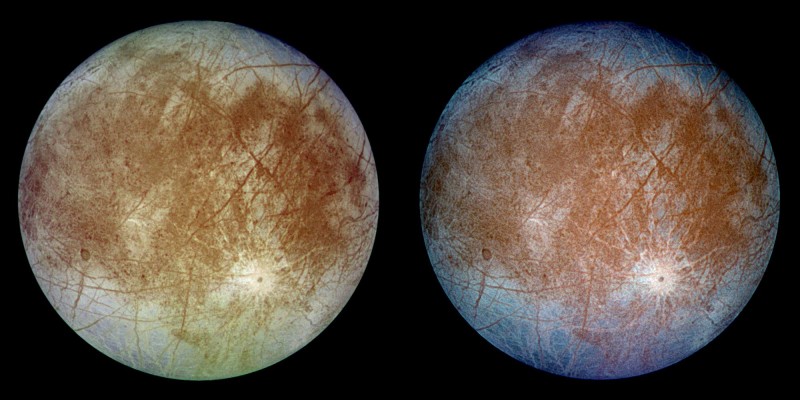
This image shows two views of the trailing hemisphere of Jupiter's ice-covered satellite, Europa.
The left image shows the approximate natural color appearance of Europa. The image on the right is a false-color
composite version combining violet, green and infrared images to enhance color differences in the predominantly water-ice crust of Europa.
This image was taken in 1996, at a range of 677,000 kilometers (417,900 miles) by the solid state imaging television camera
onboard the Galileo spacecraft during its second orbit around Jupiter.
P>
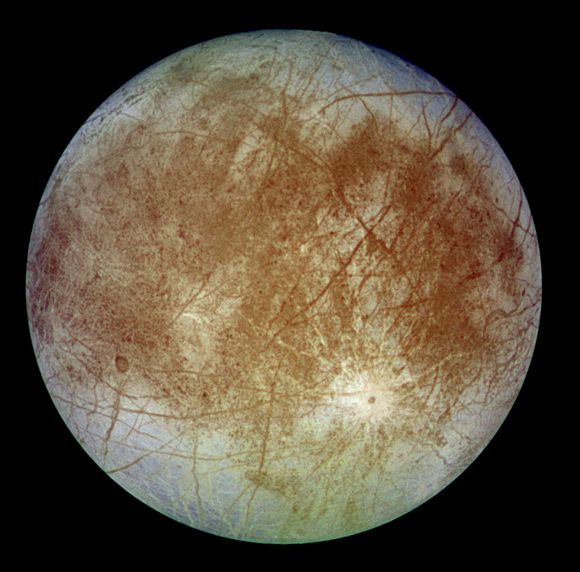
NASA?s ?Remastered? View of Europa is the Best Yet by MATT WILLIAMS on NOVEMBER 21, 2014 Europa.
The cracked, icy surface of Europa. The smoothness of the surface has led many scientists to conclude that oceans exist beneath it.
Credit: NASA/JPLredit: NASA
Published on Aug 4, 2014 Europa is a moon of Jupiter that may have three crucial ingredients for life: liquid water, energy, and nutrients. What,
if anything, can be found in the great oceans of Europa? Could NASA look for life? How could we explore affordably?
Bill Nye The Science Guy, eminent NASA scientists, and prominent legislators examined just these questions in a public event
inside the halls of Congress. This was recorded live on July 15th, 2014.
Recorded by Tushar Dayal. Speakers (in order of appearance): * Casey Dreier (Director of Advocacy for The Planetary Society and event emcee) * Rep. Lamar Smith (Chairman, House Science Committee; Texas 21st District) * Rep. John Culberson (Texas 7th District) * Rep. Adam Schiff (California 21st District) * Dr. Ellen Stofan (Chief Scientist, NASA) * Dr. Robert Pappalardo (Europa Study Scientist, JPL) * Bill Nye, The Science Guy (CEO of The Planetary Society)
Published on Nov 21, 2014 Scientists believe there is an ocean hidden beneath the surface of Jupiter's moon Europa.
NASA-JPL astrobiologist Kevin Hand explains why scientists are so excited about the potential of this ice-covered world
to answer one of humanity's most profound questions
Published on Nov 13, 2015 Could life exist on Europa? It may sound farfetched, but this Jovian moon is the most likely place to find life
in our solar system thanks to an enormous underground ocean positioned just beneath its icy surface.
Watch as Robert Pappalardo, Europa Project Scientist at NASA Jet Propulsion Laboratory, discusses Europa,
its potential for life, and the upcoming mission that is being planned to visit this compelling moon.
This video was developed from a live recording at the AIAA SPACE 2015 conference in September 2015.
To watch the full talk given at the conference click here Category People & Blogs License Standard YouTube License

Screenshot by Michelle Starr/CNET
When it comes to life, biologists have long hypothesised that its origins -- on Earth,
at least -- were in thermal vents on the ocean floor, following a period of spontaneous metabolism before life began.
Thermal vents are rich sites for marine life -- especially in Antarctica where, in the darkness under the ice,
creatures proliferate in the warm, mineral-rich waters streaming from the vents.
It's just one of several theories, but if it's correct, Jupiter's moon Europa could be a very exciting place indeed.
Ever since plumes of vapour were discovered on Jupiter's moon in December last year, NASA has been floating theories about
the oceans that may be sloshing away under the layer of surface ice -- its similarities to theories about the early Earth
look like it may have the ingredients for life.
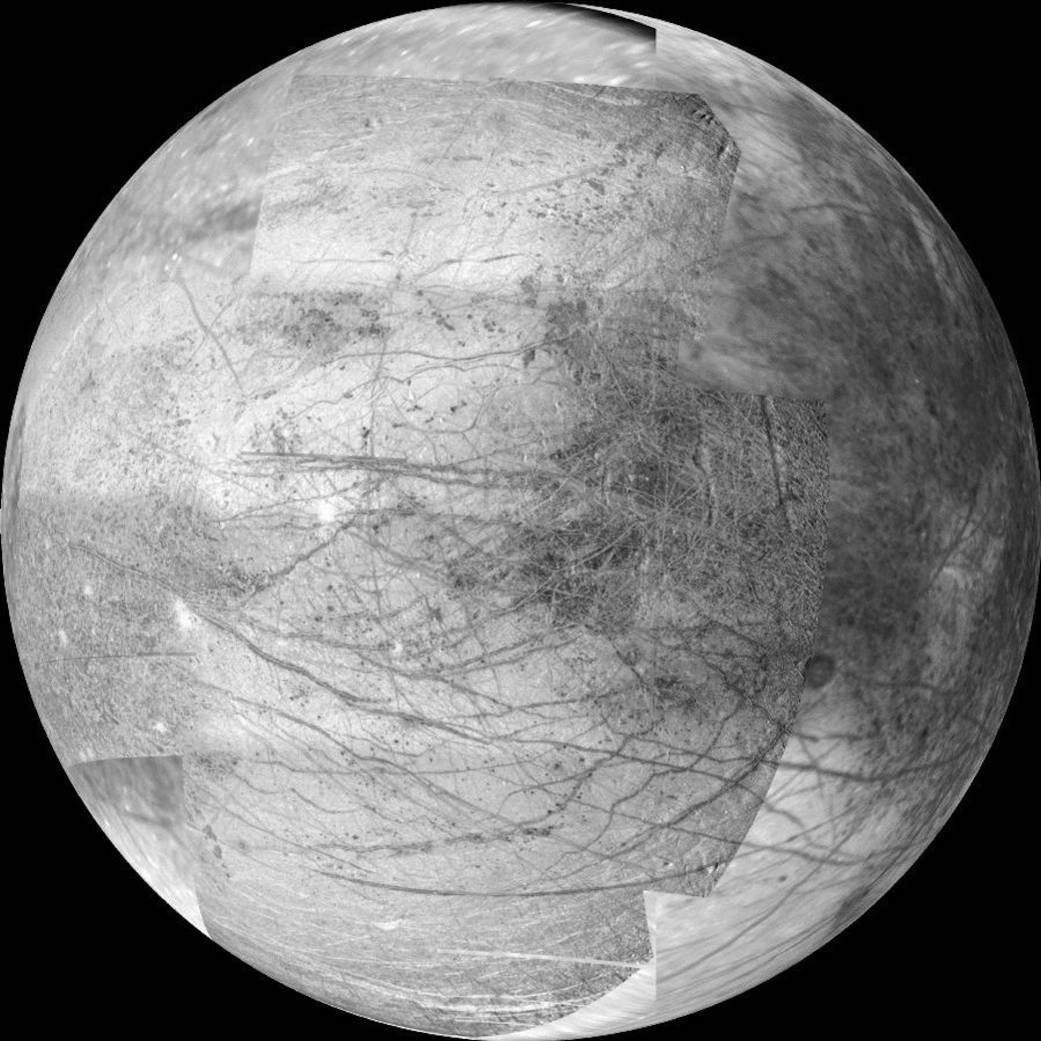
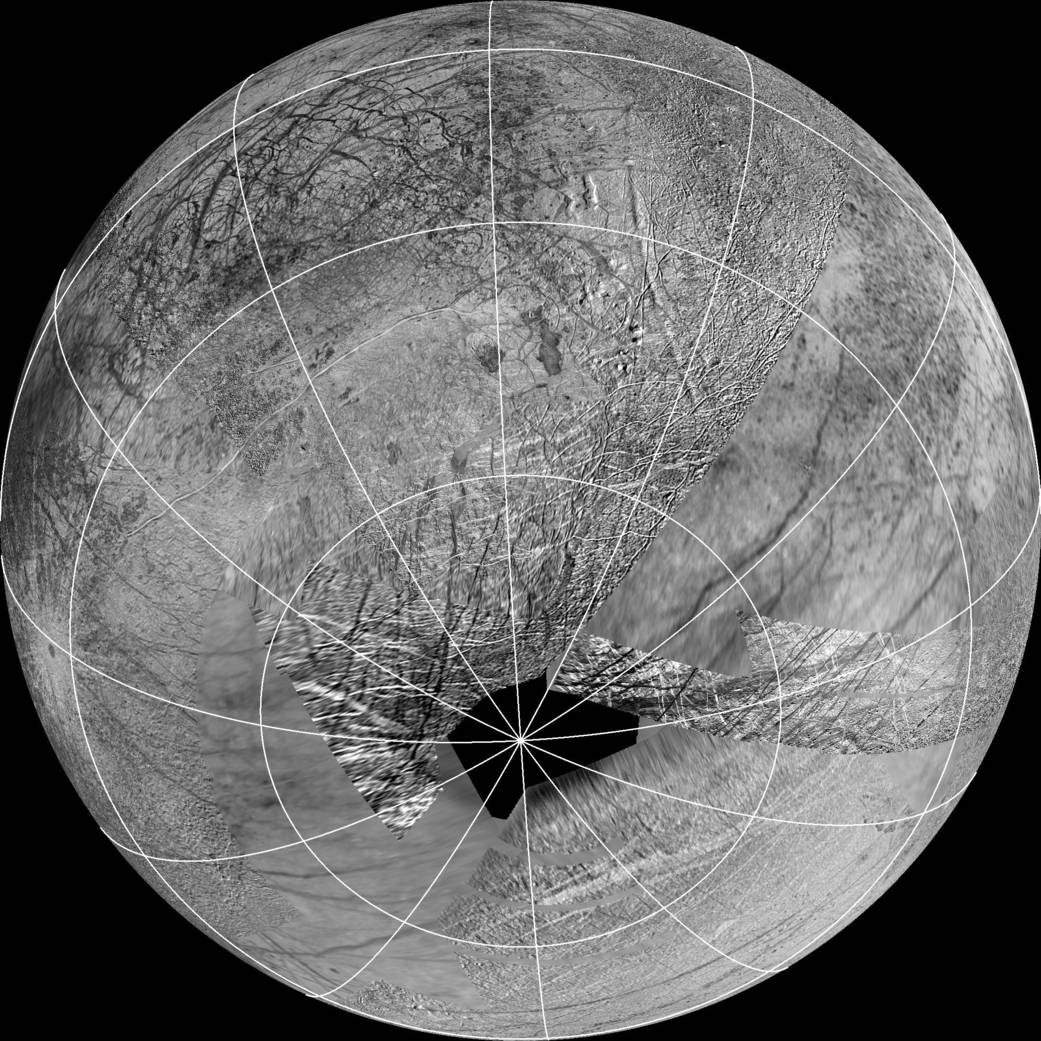
This reprojection of the official USGS basemap of Jupiter's moon Europa is centered at the estimated source region for potential water vapor plumes that might have been detected using the Hubble Space Telescope. The view is centered at -65 degrees latitude, 183 degrees longitude. In addition to the plume source region, the image also shows the hemisphere of Europa that might be affected by plume deposits. This map is composed of images from NASA's Galileo and Voyager missions. The black region near the south pole results from gaps in imaging coverage. Image Credit: NASA/JPL-Caltech/SETI Institute Last Updated: May 29, 2015 Editor: Sarah Loff
by KEN KREMER on JUNE 18, 2015
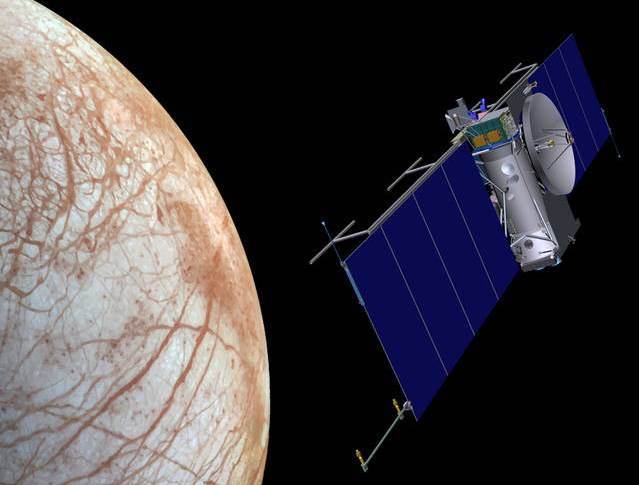
Artist’s concept of NASA mission streaking over ocean world of Europa. Credit: NASA/JPL

JA false color image shows Europa’s surprising surface. The inset includes regions where crustal plates appear to have broken up
and rafted to new positions. NASA/JPL - See more Europa’s heaving ice might make more heat than scientists thought Apr 15, 2016 A new set of experiments sheds light on how much heat is created when ice is deformed,
which could help scientists understand the possibility of a subsurface ocean on one of Jupiter’s moons Europa’s heaving ice might make more heat than scientists thought Apr 15, 2016 A new set of experiments sheds light on how much heat is created when ice is deformed,
which could help scientists understand the possibility of a subsurface ocean on one of Jupiter’s moons.
Jupiter’s moon Europa is under a constant gravitational assault. As it orbits, Europa’s icy surface heaves
and falls with the pull of Jupiter’s gravity, creating enough heat, scientists think,
to support a global ocean beneath the moon’s solid shell.
Hubble’s Surprising Find On Europa To Be Announced By NASA Monday September 26, 2016
Published: 21 Sep , 2016 by Evan Gough

NASA will make a “surprising” announcement about Jupiter’s moon Europa on Monday, Sept. 26th, at 2:00 PM EDT.
They haven’t said much, other than there is “surprising evidence of activity that may be related to the
presence of a subsurface ocean on Europa.” Europa is a prime target for the search for life because of its subsurface ocean.

Images from NASA’s Galileo spacecraft show the intricate detail of Europa’s icy surface.
Image: NASA/JPL-Caltech/ SETI Institute
What About A Mission To Europa?
Published on Jul 27, 2015 Europa’s water exists in a layer around the planet, encased in a layer of ice. Could there be life down there? Support us at: More stories at: Follow us on Twitter: @universetoday : Follow us on Tumblr Like us on Facebook: Google+ - Instagram - Team: Fraser Cain - @fcain Jason Harmer - @jasoncharmer Susie Murph - @susiemmurph Brian Koberlein - @briankoberlein Chad Weber - weber.chad@gmail.com Kevin Gill - @kevinmgill Created by: Fraser Cain and Jason Harmer

This artist’s illustration shows what plumes of water vapour might look like being ejected from Europa’s south pole.
Image: NASA, ESA, L. Roth (Southwest Research Institute, USA/University of Cologne, Germany) and M. Kornmesser.

Two models of the interior of Europa. Image: NASA/JPL.
More About Europa: The Search For Life On Europa Could Center On Celestial Party-Crashers A New Image of Europa Emerges Icy Hot: Europa’s Frozen Crust Could Be Warmer Than We Thought
Hubble may have caught jets of water squirting out of a potentially habitable moon Dave Mosher,Business Insider

A plume of subsurface ocean water vapor escapes through a crack in the icy crust of Europa, a moon of Jupiter CREDIR:.NASA/ESA/K. Retherford/SWRI) Jupiter's moon Europa — a giant ice ball thought to hide twice as much liquid water as there is on Earth —
just became an even hotter target in the search for aliens. Scientists on Monday unveiled new photographs from NASA's Hubble Space Telescope, and they likely show "fingers"
of water vapor squirting out of Europa's hidden ocean and into space.

(Suspected plumes of water vapor spouting out of Jupiter's moon Europa.Hubble/NASA/STScI/Business Insider) Those blotchy "dark fingers," circled in red, are the suspected plumes.

During a press teleconference on Monday, William Sparks, an astronomer at the Space Telescope Science Institute, said
"we are really working at the limits of Hubble's unique capabilities." "Trying to just image Europa with the Hubble Space Telescope clearly from Earth is challenging," Pappalardo said.
"Trying to image the [silhouette] of a plume, via the light of Jupiter, is a remarkably hard feat.
There's essentially a lot of noise in the system." NASA's press materials lean heavily on the word "if" as well (our emphasis added): "These plumes, if they do indeed exist, may provide another way to sample Europa's subsurface,"
Geoff Yoder, the associate administrator for NASA's Science Mission Directorate, said in the space agency's release. Another "if" regarded the moon's water-enriched atmosphere: "If there is a thin atmosphere around Europa,
it has the potential to block some of the light of Jupiter, and we could see it as a silhouette," Sparks said in the release.
The next mission to Europa

(This artist's rendering shows a concept for a future NASA mission to Europa in which a spacecraft would make multiple close flybys of the icy Jovian moon,
thought to contain a global subsurface ocean.NASA/JPL-Caltech)
Animation - Plumes on Europa
Uploaded on Sep 26, 2016 Artist’s concept: Astronomers using NASA's Hubble Space Telescope have imaged what may be water vapor plumes erupting off the surface of Jupiter's moon Europa. If the plumes, indeed, emerge and rain down on the surface, it may be much easier to access material that was once in the ocean of Europa. News release: Category Science & Technology License Standard YouTube License

Europa transit illustration. Europa orbits Jupiter every 3 and a half days, and on every orbit it passes in front of Jupiter,
raising the possibility of plumes being seen as silhouettes absorbing the background light of Jupiter.
Credits: A. Field (STScI)
EUROPA LANDER COULD CARRY A MICROPHONE AND “LISTEN” TO THE ICE TO FIND OUT WHAT’S UNDERNEATH

Artist's rendering of a possible Europa Lander mission, which would explore the surface of the icy moon in the coming decades. Credit:: NASA/JPL-Caltech

Image of Europa’s ice shell, taken by the Galileo spacecraft, of fractured “chaos terrain”. Credit: NASA/JPL-Caltech

Europa’s “Great Lake.” Scientists speculate many more exist throughout the shallow regions of the moon’s icy shell. Credit: Britney Schmidt/Dead Pixel FX/Univ. of Texas at Austin.

Artist’s concept of chloride salts bubbling up from Europa’s liquid ocean and reaching the frozen surface. Credit: NASA/JPL-Caltech

This animation demonstrates how deformation in the icy surface of Europa could transport subsurface ocean water to the moon’s surface. This is just one of several simulated behaviors reported in a new study performed by scientists at NASA’s Jet Propulsion Laboratory. The study focused on linear features called “bands” and “groove lanes” found on Jupiter’s moons Europa and Ganymede. Scientists have used the same numerical model to solve mysteries about motion in Earth’s crust. The animation is a two-dimensional simulation of a possible cross-section of a band running through Europa’s ice shell. At the extreme bottom is Europa’s ocean, and the thick white line across the top represents the moon’s surface ice. The midsection is the bulk of Europa’s ice shell, with warmer colors (red, orange, yellow) representing stronger, more rigid ice. Depth is marked on the left side of the animation while numbers on the bottom measure distance from the center of the band feature on Europa’s surface. Bands on Europa and Ganymede are typically tens of miles wide and hundreds of miles long. Numbers at the top mark the passage of time in thousands of years. As the animation runs forward, the ice shell is deformed by gravitational interactions with Jupiter. The cold, brittle ice at the surface gets pulled apart. At the same time, faults in the upper ice form, heal, and re-form (visible as diagonal yellow, green and blue lines in the upper center of the animation). The churning material that quickly fills the bottom half of the view is a collection of tiny white dots representing bits of Europa’s ocean that have been frozen into the bottom of Europa’s ice shell (i.e. where the liquid ocean is in contact with the frozen shell). In the paper, the scientists describe it as “fossil” ocean material because the bits of ocean trapped in Europa’s ice shell spend many hundreds of thousands, if not millions, of years being carried to the surface. In other words, by the time the ocean material reaches Europa’s surface where it can be analyzed by a passing spacecraft, it no longer serves as a sample of Europa’s ocean as it is in the present. Instead, the spacecraft would actually be studying Europa’s ocean as it was a million or more years ago. Hence, it is fossil ocean material. NASA’s Europa Clipper spacecraft is intended to launch in the early 2020s. The spacecraft will then orbit Jupiter and become the first spacecraft to study Europa exclusively, including the composition of the moon’s surface material. The mission will likely be able to test the model simulated above by using ice-penetrating radar to probe the moon’s bands. If Europa indeed behaves the way the simulation suggests, it might carry ocean material to the moon’s surface, where Europa Clipper would analyze it remotely using the spacecraft’s infrared and ultraviolet instruments, among others. Scientists could then study the material’s composition to consider whether Europa’s ocean might be hospitable for some form of life. Gretchen McCartney Jet Propulsion Laboratory, Pasadena, Calif. 818-393-6215 gretchen.p.mccartney@jpl.nasa.gov animation credits: NASA/JPL-Caltech/Samuel M. Howell

Images from NASA’s Galileo spacecraft show the intricate detail of Europa’s icy surface. Image: NASA/JPL-Caltech

Based on new evidence from Jupiter's moon Europa, astronomers hypothesize that chloride salts bubble up from the icy moon's global liquid ocean and reach the frozen surface where they are bombarded with sulfur from volcanoes on Jupiter's innermost large moon Io. The new findings propose answers to questions that have been debated since the days of NASA's Voyager and Galileo missions. This illustration of Europa (foreground), Jupiter (right) and Io (middle) is an artist's concept. Credit: NASA/JPL-Caltech


Radiation from Jupiter can destroy molecules on Europa's surface. Material from Europa's ocean that ends up on the surface will be bombarded by radiation, possibly destroying any biosignatures, or chemical signs that could imply the presence of life. Credit: NASA/JPL-Caltech

Artist’s concept of chloride salts bubbling up from Europa’s liquid ocean and reaching the frozen surface. Credit: NASA/JPL-Caltech

Artist’s concept of a Europa Clipper mission. Credit: NASA/JPL

A plume of subsurface ocean water vapor escapes through a crack in the icy crust of Europa, a moon of Jupiter CREDIR:.NASA/ESA/K. Retherford/SWRI) Jupiter's moon Europa — a giant ice ball thought to hide twice as much liquid water as there is on Earth —
just became an even hotter target in the search for aliens. Scientists on Monday unveiled new photographs from NASA's Hubble Space Telescope, and they likely show "fingers"
of water vapor squirting out of Europa's hidden ocean and into space.

The search for life has led astronomers to the icy moons in our Solar System. Among those moons, Europa has attracted a lot of attention. Europa is Jupiter’s fourth-largest moon—and the sixth-largest in the Solar System—at 3,100 kilometres (1,900 mi) in diameter. Scientists think that its oceans could contain two or three times as much water as Earth’s oceans. The only problem is, that water is hidden under a sheet of planet-wide ice that could be between 2km and 30km (1.2 miles and 18.6 miles) thick.

Two models of the interior of Europa. A tunneling robot would be able to tunnel through the ice and search for life. Image: NASA/JPL.

Reprocessed Galileo image of Europa’s frozen surface by Ted Stryk (NASA/JPL/Ted Stryk)

Images from NASA’s Galileo spacecraft show the intricate detail of Europa’s icy surface. A tunnelling robot would be just the vehicle to explore the oceans under the ice. Image: NASA/JPL-Caltech/ SETI Institute

Image of Europa’s ice shell, taken by the Galileo spacecraft, of fractured “chaos terrain.” A tunneling robot would likely be sent to this type of surface area. Image Credit: NASA/JPL-Caltech
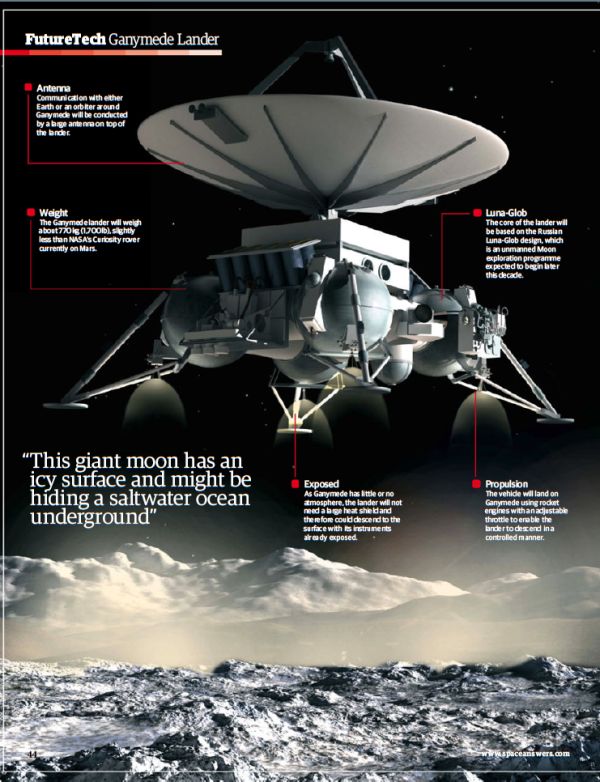

Russia's Proposed Mission to Ganymede in russian! Ганимед: на пороге открытий
Published on Jul 29, 2016 В НПО имени Лавочкина, где создавались все отечественные межпланетные станции, а сейчас строятся аппараты
лунной программы и орбитальные обсерватории серии «Спектр», прорабатывается проект «Лаплас». Это два аппарата,
которые в ближайшее десятилетие планируют отправить к Юпитеру. Цель исследований - спутник Юпитера – Ганимед.
Еще один объект изучения – Меркурий. Планета входит в т.н. «земную группу планет», но знания землян о нем – самые общие.
Этот пробел должна восполнить миссия «БепиКоломбо». В проекте принимают участие ЕКА, Роскосмос и JAXA.
На аппарате, который отправится к самой маленькой планете Солнечной системы через два года, будет установлен
российский прибор для поиска воды. Category Science & Technology License Standard YouTube License


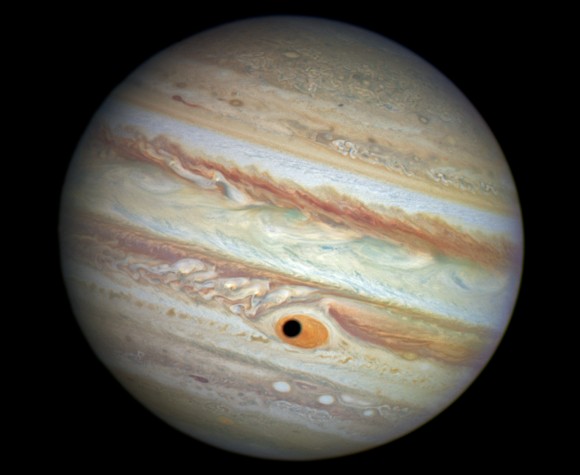
Jupiter's Great Red Spot and Ganymede?s Shadow.(Ganymede the largest moon in the solar system) Image Credit: NASA/ESA/A. Simon (Goddard Space Flight Center)
Halloween is just around the corner. And in what appears to be an act of cosmic convergence, Hubble captured a spooky image of Jupiter
staring back at us with a cyclops eye!
While this is merely a convenient illusion caused by the passage of Ganymede in front of Jupiter ?
something it does on a regular basis ? the timing and appearance are perfect.
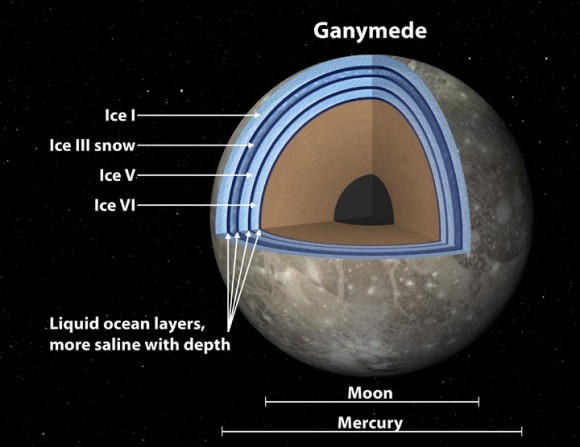
Ganymede?s Subsurface Ocean is Like a Club Sandwich by Nancy Atkinson on May 1, 2014 Read more: www.universetoday...
This image of Ganymede, one of Jupiter's moons and the largest moon in our solar system was taken by NASA's Galileo spacecraft. Image Credit: NASA
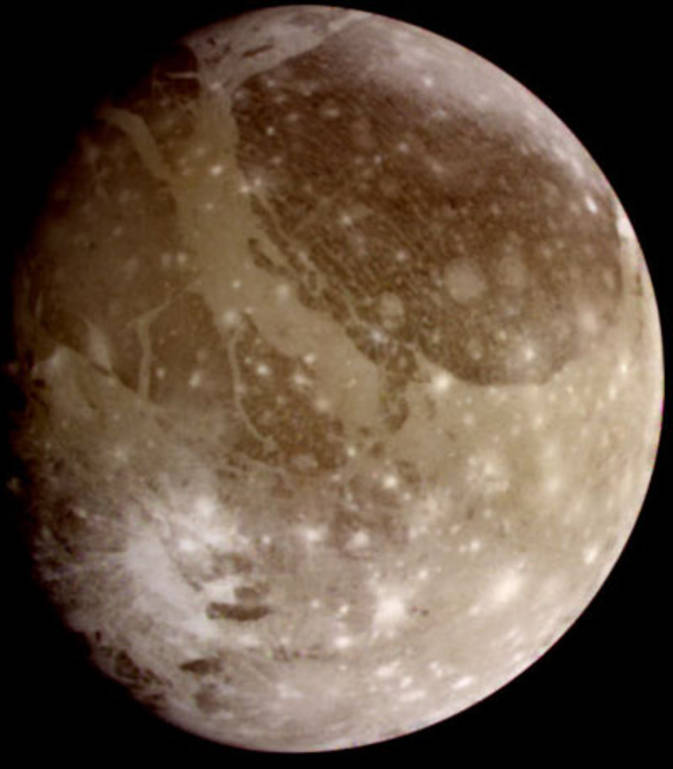
This image of Ganymede, one of Jupiter's moons and the largest moon in our solar system was taken by NASA's Galileo spacecraft. Image Credit: NASA

Many people think that the answer to ‘what is the largest moon in the Solar System’ is our Moon.
It is not. Our Moon is the fifth largest natural satellite. Ganymede, a moon of Jupiter, is the largest in this solar system.
At 5,268 km at the equator Image Credit: NASA

Montage showing New Horizons’ views of Ganymede taken by it’s infrared spectrometer and LORRI and LEISA instruments.
Credit: NASA/Johns Hopkins University APL/SwRI


that envisioned sending a spacecraft to inspect Callisto,
Ganymede and Europa. Credit: NASA/JPL
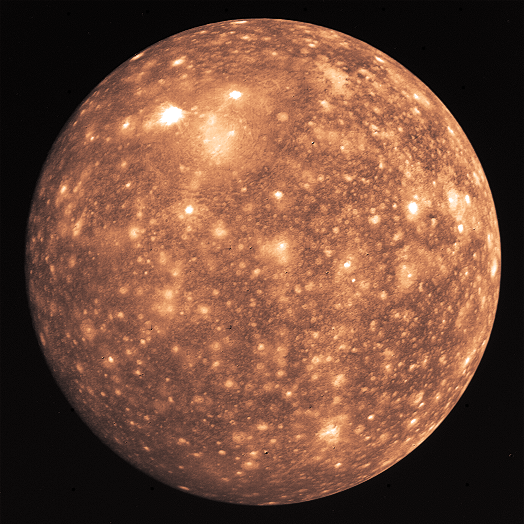
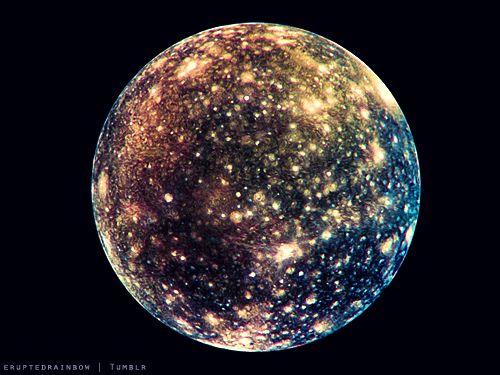
Uploaded on Jan 6, 2010 Callisto (pronounced /kəˈlɪstoʊ/,or as Greek Καλλιστώ) is a moon of the planet Jupiter, discovered in 1610 by Galileo Galilei.
It is the third-largest moon in the Solar System and the second largest in the Jovian system, after Ganymede.
Callisto has about 99% the diameter of the planet Mercury but only about a third of its mass. It is the fourth Galilean moon of Jupiter by distance,
with an orbital radius of about 1 880 000 km. It does not form part of the orbital resonance that affects three inner Galilean satellites—Io, Europa and Ganymede—
and thus does not experience appreciable tidal heating. Callisto rotates synchronously with its orbital period, so the same face is always turned toward Jupiter.
Callisto's surface is less affected by Jupiter's magnetosphere than the other inner satellites because it orbits farther away.
Callisto is composed of approximately equal amounts of rock and ices, with a mean density of about 1.83 g/cm3. Compounds detected
spectrally on the surface include water ice, carbon dioxide, silicates, and organic compounds. Investigation by the Galileo spacecraft
revealed that Callisto may have a small silicate core and possibly a subsurface ocean of liquid water at depths greater than 100 km.
The surface of Callisto is heavily cratered and extremely old. It does not show any signatures of subsurface processes such as plate tectonics,
earthquakes or volcanoes, and is thought to have evolved predominantly under the influence of impacts. Prominent surface features include multi-ring structures,
variously shaped impact craters, and chains of craters (catenae) and associated scarps, ridges and deposits. At a small scale, the surface is varied and consists of small,
bright frost deposits at the tops of elevations, surrounded by a low-lying, smooth blanket of dark material. This is thought to result from the sublimation-driven degradation
of small landforms, which is supported by the general deficit of small impact craters and the presence of numerous small knobs, considered to be their remnants.The absolute ages
of the landforms are not known. Callisto is surrounded by an extremely thin atmosphere composed of carbon dioxide[6] and probably molecular oxygen, as well as by a rather intense ionosphere. Callisto is thought
to have formed by slow accretion from the disk of the gas and dust that surrounded Jupiter after its formation. Its slowness and the lack of tidal heating prevented rapid differentiation.
The slow convection in the interior of Callisto, which commenced soon after formation, led to partial differentiation and possibly to the formation of a subsurface ocean at a depth of 100150 km and a small, rocky core.
The likely presence of an ocean within Callisto indicates that it can or could harbor life. However, this is less likely than on nearby Europa. Various space probes from Pioneers 10 and 11 to Galileo and Cassini have studied the moon.
Callisto has long been considered the most suitable place for a human base for future exploration of the system of Jupiter. Discovered by G. Galilei S. Marius Discovery date January 7, 1610 Designations Alternate name Jupiter IV Adjective Callistoan, Callistian Orbital characteristics Periapsis 1 869 000 km[b] Apoapsis 1 897 000 km[a] Mean orbit radius 1 882 700 km Eccentricity 0.007 4 Orbital period 16.689 018 4 d Average orbital speed 8.204 km/s Inclination 0.192° (to local Laplace planes) Satellite of Jupiter Physical characteristics Mean radius 2410.3 ± 1.5 km (0.378 Earths) Surface area 7.30 × 107 km2 (0.143 Earths) Volume 5.9 × 1010 km3 (0.0541 Earths) Mass 1.075 938 ± 0.000 137 × 1023 kg (0.018 Earths) Mean density 1.834 4 ± 0.003 4 g/cm3[3] Equatorial surface gravity 1.235 m/s2 (0.126 g) Escape velocity 2.440 km/s Rotation period synchronous Axial tilt zero Albedo 0.22 (geometric) Surface temp. K[4] min mean max 80 ± 5 134 ± 11 165 ± 5 Apparent magnitude 5.65 (opposition) Atmosphere Surface pressure 7.5 pbar Composition ~4 × 108 cm−3 carbon dioxide up to 2 × 1010 cm−3 molecular oxygen Category Science & Technology License Standard YouTube License

Model of Callisto’s internal structure showing a surface ice layer, a possible liquid water layer, and an ice–rock interior.
Credit: NASA/JPL

Interior density structures created by an outer solar system late heavy bombardment onto Ganymede (top row) and Callisto (bottom row).
Credit: SwRI

Voyager 1 image of Valhalla, a multi-ring impact structure 3800 km in diameter. Credit: NASA/JPL

New Horizons Long Range Reconnaissance Imager (LORRI) captured these two images of Jupiter’s outermost large moon, Callisto,
during its flyby in February 2007. Credit: NASA/JPL

Artist’s impression of a base on the icy surface of Callisto. Credit: NASA